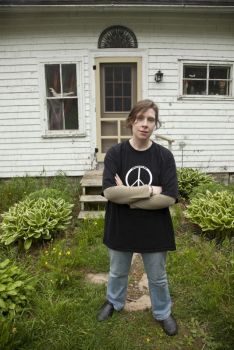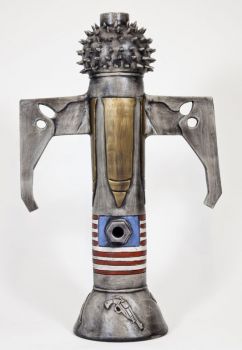Artist Bio
 Shanna Wheelock
Shanna Wheelock
My work is guided by sense of place, a desire for connection, and a curiosity for the creative process. I am intrigued by Edgar Cayce’s idea that geographic locations emanate their own signature vibration. For the past eighteen years I have lived in a remote fishing village that by some estimations is the “edge of the earth.” It is sparsely populated and located at the easternmost reaches of the United States, bordered by a small Canadian Island and vast sea. Lubec is a town that some describe as a spiritual portal which contains a signature energetic vibration through a combination of strong tidal resonance and its people and their history. The artwork that I create is not only a response to this energy, but an honoring of the community and the generations of people who have lived and worked here before me. While my work often represents the social structure of this particular geographic space, the symbols used within my work also serve as a metaphor for my own experiences and beliefs.
Artist Statement
 US Totem by Shanna Wheelock
US Totem by Shanna Wheelock
Water, Wind, and Time
A Maine native, I came to live in a remote fishing village bordering Canada just over a decade ago. A potter by trade as well as a sculptor and weaver, the area in which I live has influenced my work on many levels. I gather inspiration from the natural environment as well as the local history and culture.
My current series "Water, Wind, and Time" focuses on the deterioration of local sardine industry. Factories, abandoned buildings, war, machines, and spirit are themes that have been with me since a young age. Columbian Canning Plant, also known as Factory C, evokes images of all these things. Its war-torn appearance is indicative of battling the elements while the energy of workers who moved with machine like precision hovers in stillness.
My connection to abandoned spaces harkens back to an early memory of coming home from school and seeing the old barn that I once played in being torn down. I sat on the stoop of our newly built house and watched silently from afar as bulldozers and chains razed the wooden structure. Even at nine years old I had developed a bond with the dilapidated building: its thick vertical beams, marred wooden floor, empty stalls, and cracked-glass windows. That affinity for things ancient carried throughout my work as an artist, as well as the machine-like repetition that is epitomized by the inner workings of factories.
I moved to this remote fishing village when the last working factory had just ceased operation. Economic collapse and despair emanated throughout. Stories of nostalgia told of the "olden days" when wealth was as fluid as the tides. Abandoned buildings were left to fend for themselves amidst the brutal forces of nature.
My work segued into an in-depth study of our community's former factory days. At first I found only small piles of debris, old bricks and shingles. These items were integrated into clay and told, more or less, the story of a once-thriving sardine industry. I connected with one of our town's elders: a ninety-four year old woman who prided herself as a former "herring choker." I initiated the interviews expecting to hear accounts of misery and corruption, but instead I was privy to stories that defined factory life as an extension of family where stability and friendships were formed. I soon felt an urgent calling to make my way to the site of the old Columbian Canning Plant. For years I had driven the main road through town and peered over tree tops at a crumbling roof. With tide and weather finally cooperating, I made my way down a snow-lined path to the shorefront construction.
When I walked inside my heart skipped a beat. All the sculpture I had been creating in the past few years suddenly made sense. Heavy rectangular concrete columns, some erect and some fallen to a diagonal slant, barely supported the weight of a collapsing roof. Tangled rebar and stones poked through cement slabs. Masses of debris piled itself along the interior. It amazed me to know that this was not a war-torn village and that these walls and ceilings did not collapse because of bombs. Merely, it was water, wind, and time that eroded.
Outside, weathered pilings emerged from the sand as if they were guardians watching over the remains of the factory. There was a silence and a sacredness that settled deep. My connection to these buildings inhabits a space in my soul. I think of the energy in the materials, the tree that was sacrificed for the lumber, the hands that mixed the concrete, and the experiences of the bodies that once filled the space.
Political Works
War, nuclear disaster, corruption. We are inundated with news that somehow tricks us, makes us believe that the health of both human and Earth is hostage to profit. My sculptures comment on this social dysfunction and reflect my struggle in the face of insane dualities. A person of peace, I have a dark edge, and must delve into it, ultimately, to ground my protest. Although the images may invoke violence and pain, they establish a source of hope. Repetition, in one sense a symbol of machine drudgery, harbors an ironic depth: a creative state of profound concentration.
Even when crafting grenades, I find peace.
Repetition can be reclaimed. It yields a statement against the Mechanism in which we are slated to conform. Although I find peace in art's repetition, countless souls suffer to keep our mechanized world functioning. Mechanization in this mode is a psychotic trajectory, extending from factory to war to fanatic ideologies, whether religious or avaricious.
With my sculptures, I portray the road to doom as superficially appealing. The shine of gunmetal. The streamline of a bullet. The virile thrust of a missile. And, riding these, the glamour of the patriotic hero who dies for a falsified cause. Through repetition and devilish aesthetics, I present our collective fascination and glorification of things that work to destroy our best works, and everything else.
We are fortunate to live in a world where color and imagination are part of our everyday existence.
~ Shanna Wheelock
